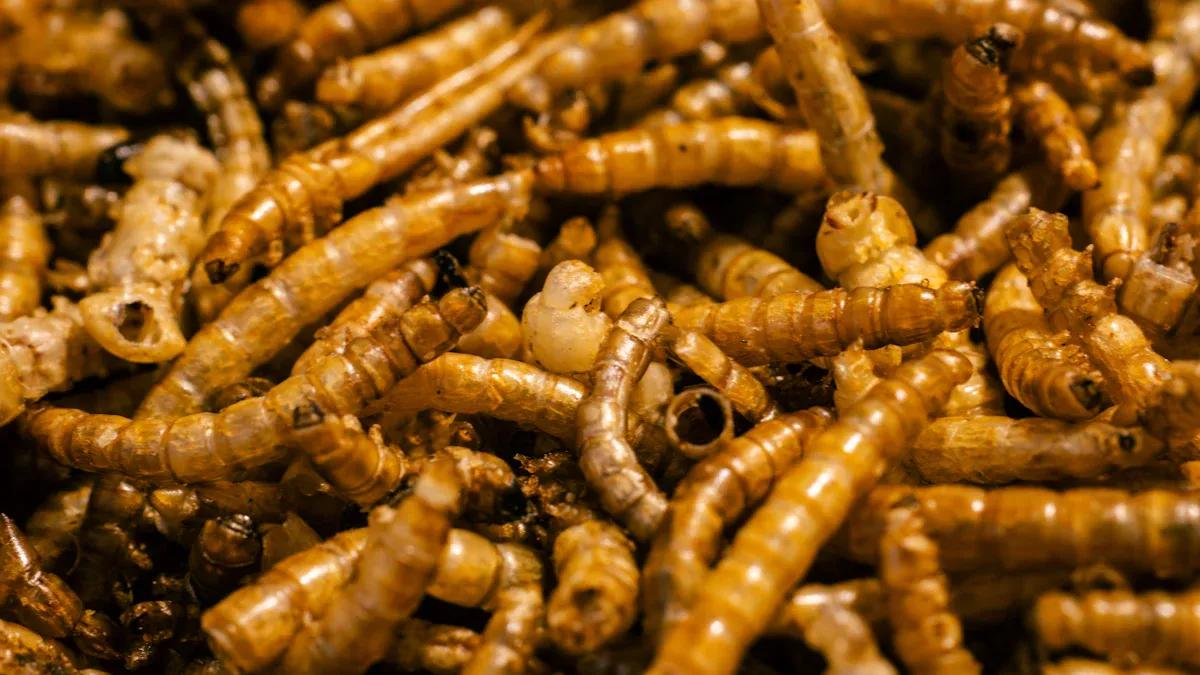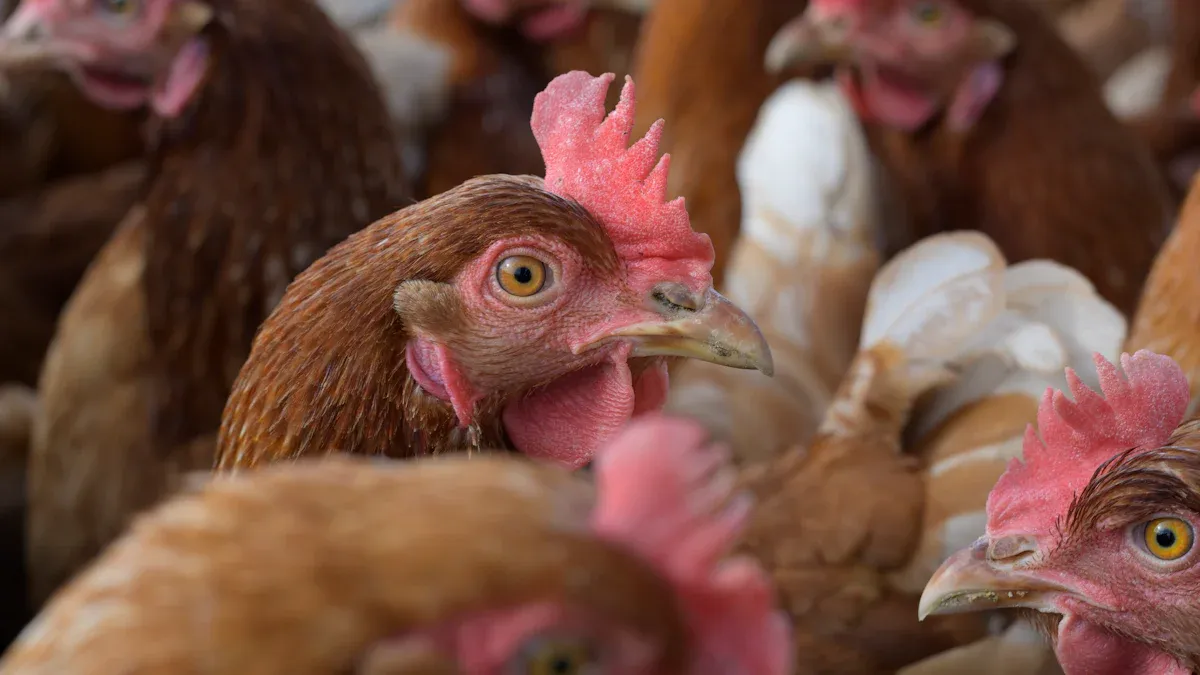
Have you noticed how dried mealworms for poultry are gaining popularity across Europe? It’s no surprise! These tiny insects pack a punch when it comes to nutrition. With a protein content of 51.93%, they outperform traditional options like soybeans. Plus, studies show they improve growth in broilers and quails. Their eco-friendly production also makes them a sustainable choice. But before diving in, it’s important to understand the legal and environmental aspects of using them.
Key Takeaways
- Dried mealworms are very nutritious, with 51.93% protein. This helps poultry grow and stay healthy.
- Using dried mealworms can help farmers save money and time. It also makes raising poultry more effective.
- Dried mealworms support eco-friendly farming. They use fewer resources and lower greenhouse gases.
Nutritional Benefits of Dried Mealworms for Poultry

High Protein Content and Essential Nutrients
Did you know dried mealworms are a powerhouse of nutrition for your poultry? These tiny insects are packed with 40-60% protein, making them an excellent source of essential amino acids. Protein is vital for your birds’ growth, muscle development, and overall health. Plus, dried mealworms contain fats and fibers that support energy levels and digestion.
Here’s a quick comparison of their nutritional value:
| Type | Protein (%) | Fat (%) | Fiber (%) |
|---|---|---|---|
| Dried Mealworms | 53 | 28 | 6 |
| Live Mealworms | 20 | 13 | 2 |
With such a high protein content, dried mealworms for poultry are a game-changer. They even outperform traditional feeds like soybeans in terms of nutritional value.
Supporting Growth, Egg Production, and Health
If you’re looking to boost your poultry’s growth and egg production, dried mealworms are the way to go. Studies show that adding mealworms to your birds’ diet improves growth performance in broilers and quails. The protein and nutrients in mealworms also enhance egg quality and production.
But that’s not all. Mealworm protein helps repair body tissues and strengthens immunity. This means your birds stay healthier and recover faster from injuries or illnesses. It’s like giving them a natural health boost every day!
Advantages Over Traditional Feed Options
Why choose dried mealworms over traditional feeds? For starters, they have a higher protein content—51.93% compared to 44.51% in soybeans. They’re also more cost-effective and require less space to produce.
| Aspect | Mealworms | Soybeans |
|---|---|---|
| Protein Content | 51.93% | 44.51% |
| Feed Efficiency | Higher | Lower |
| Cost of Production | Less expensive | More expensive |
| Space Requirement | Requires less | Requires more |
Switching to dried mealworms for poultry not only benefits your birds but also saves you money and resources. It’s a win-win for you and your farm!
Legal and Regulatory Considerations in Europe
Current EU Guidelines on Insect-Based Feed
You might be wondering, “Are dried mealworms for poultry even allowed in Europe?” The good news is that the EU has been making strides in regulating insect-based feed. Regulations like (EU) 2017/893 and (EU) 2021/1372 now permit processed animal protein from specific insect species for aquaculture, poultry, and pig feed. This is a big step forward for sustainable farming practices.
The European Food Safety Authority (EFSA) has also played a key role. They’ve conducted risk assessments and approved dried Tenebrio molitor larvae for food products. However, EFSA has flagged potential allergen risks, especially for individuals allergic to crustaceans or dust mites. This highlights the importance of monitoring allergens in insect-based feed.
Country-Specific Restrictions and Compliance
While the EU sets overarching guidelines, individual countries have their own rules. Some nations are more cautious, requiring strict compliance with food safety standards. For example, only 28% of EU insect feed companies manage the entire process from rearing to processing. Most rely on sourcing dried insects, which means regulations must ensure safety at every step.
If you’re considering using dried mealworms for poultry, it’s crucial to stay updated on your country’s specific requirements. This ensures you remain compliant while reaping the benefits of this innovative feed option.
Future Prospects for Legal Acceptance
The future looks bright for insect-based feed in Europe. Companies are actively submitting applications for novel food approvals, like those for Tenebrio molitor. Market forecasts predict that by 2030, 39 million EU consumers will include insects in their diets. This growing acceptance could pave the way for even more relaxed regulations.
However, challenges remain. Food safety and processing methods need further research to address regulatory concerns. With ongoing advancements, you can expect insect-based feed to become a mainstream option in the coming years.
Sustainability and Environmental Impact
Eco-Friendly Farming Practices
Switching to dried mealworms for poultry can revolutionize farming practices. These insects require fewer resources to produce compared to traditional livestock. For example, mealworm farming uses significantly less land, water, and energy. This makes it a more sustainable option for farmers looking to reduce their environmental footprint.
Here’s a quick comparison:
| Metric | Mealworm Farming | Traditional Livestock Farming |
|---|---|---|
| CO2 Emissions (kg CO2 eq/kg) | 20.4 | Higher |
| Land Occupation (m²/kg) | 22.38 | Higher |
| Energy Use (MJ-eq/kg) | 213.66 | Higher |
| Greenhouse Gas Emissions (kg CO2 eq) | 3.8 | Higher |
Mealworm farming also produces frass, a nutrient-rich byproduct that can replace synthetic fertilizers. This supports healthier soil and reduces the need for chemical inputs.
Reduced Resource Use and Carbon Emissions
Mealworms are champions of efficiency. Producing them requires far less water and land than raising cattle or chickens. For instance, the water footprint of mealworms is just 4341 m³ per ton, compared to 15100 m³ per ton for beef.
| Metric | Mealworms | Beef |
|---|---|---|
| Water Footprint | 4341 m³/t | 15100 m³/t |
| Land Requirement | Less than beef or chicken | N/A |
| Energy Use | 213.66 MJ-eq | N/A |
| CO2 Emissions | 20.4 kg/kg | N/A |
By choosing dried mealworms for poultry, you’re not just feeding your birds—you’re actively reducing greenhouse gas emissions and conserving vital resources.
Contribution to Circular Agriculture
Dried mealworms play a key role in circular agriculture. They can convert food waste into high-quality protein, closing the loop in agricultural systems. Their frass improves soil health more effectively than synthetic fertilizers or animal manure.

Here’s how they contribute:
- Enhance livestock health and productivity as a feed supplement.
- Support soil fertility when used as compost or fertilizer.
- Reduce greenhouse gas emissions and resource use compared to traditional livestock.
By incorporating dried mealworms into your farming practices, you’re not only improving efficiency but also promoting a more sustainable future.
Practical Tips for Using Dried Mealworms
Feeding Schedules and Quantities
When it comes to feeding your poultry dried mealworms, balance is key. These protein-packed treats should make up about 5-10% of your birds’ total feed. For example, if your chickens eat half a cup of feed daily, you can add up to one tablespoon of dried mealworms. This small addition can work wonders for their growth and gut health.
Start slow if you’re introducing mealworms for the first time. Gradually increase the quantity to avoid overwhelming their digestive systems. Remember, moderation is essential to keep your birds healthy and happy.
Storage and Handling Best Practices
Proper storage ensures your dried mealworms stay fresh and safe for your poultry. Always keep them in an airtight container to prevent moisture from seeping in. Store the container in a cool, dry place away from direct sunlight. This helps maintain their nutritional value and prevents spoilage.
Before feeding, check for any signs of contamination or spoilage. Regularly inspect the container and its contents to ensure everything is in good condition. By following these steps, you can protect your investment and provide your birds with high-quality feed.
Cost-Effective Sourcing for Farmers
Dried mealworms for poultry are not only nutritious but also cost-effective. Their long shelf life reduces waste and storage issues, saving you money in the long run. Plus, they don’t attract pests as much as traditional feed, keeping your storage areas cleaner.
To cut costs further, consider buying in bulk from reputable suppliers. Bulk purchases often come with discounts, making it easier to manage expenses. By sourcing wisely, you can enjoy the benefits of mealworms without breaking the bank.
Dried mealworms for poultry offer a trifecta of benefits. They’re rich in protein and essential amino acids, boosting growth and digestion. Their production emits far less CO2 and uses minimal land and energy, making them eco-friendly. Legal strides in Europe are paving the way for wider adoption. These tiny insects could transform poultry farming into a sustainable powerhouse.
FAQ
What are the main benefits of feeding dried mealworms to poultry?
Dried mealworms provide high protein, essential nutrients, and energy. They improve growth, egg production, and immunity, making your birds healthier and more productive. 🐔✨
Are dried mealworms safe for all types of poultry?
Yes, they’re safe for chickens, ducks, quails, and more. Just introduce them gradually to avoid digestive issues and ensure your birds adjust well to the new feed.
How can I store dried mealworms properly?
Keep them in an airtight container in a cool, dry place. This prevents moisture and spoilage, ensuring your mealworms stay fresh and nutritious for your poultry. 🛑💧


